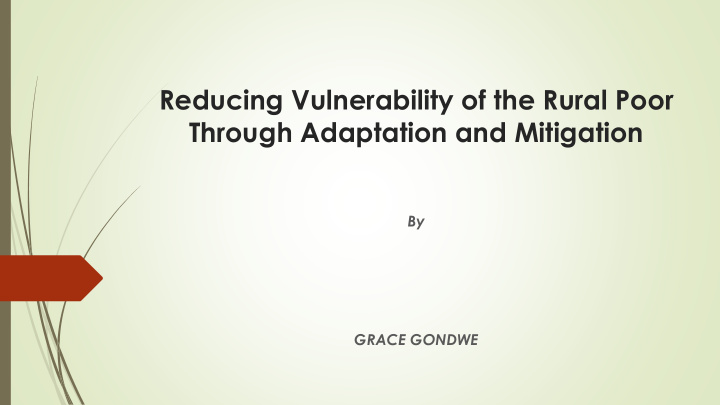



Reducing Vulnerability of the Rural Poor Through Adaptation and Mitigation By GRACE GONDWE
OUTLINE Introduction Vulnerability in the context of climate change and poverty reduction Adaptation and Mitigation: Best practices Conclusion and policy recommendation
Introduction Agenda 2030: Commits to eradicate poverty (goal 1.1 &1.2) Definition of the poor $1.90/day; 10% of global population Mostly rural dwellers-climate sensitive activities This paper: Address vulnerability through adaptation and mitigation Focus is on best practices and lessons
Vulnerability in the context of climate change and poverty Reduction Anticipate and mitigate; cope and recover Disproportionately affect the poor Combination of socio-economic factors Livelihood options & productive assets 75%-subsistence rain-fed agriculture- huge poverty perpetuation risk At least 25% climate related damages Up to 80% losses-disrupted rainfall Empirically validated Cyclone in Madagascar: poverty by 7.8% (Andrianarimanana, 2015) Hurricane in Nicaragua : 165m joined extreme poverty group; 18% loss (Herera et.al., 2018) Flood in Mumbai: 3 times losses for the poor (FAO, 2018)
Vulnerability in the context of climate change and poverty Reduction Cnt’d Poverty is not the same as vulnerability though closely linked E.g. poor with increased capacity to mitigate and adapt is less vulnerable to climate change shocks than a wealthier person who is not prepared Contrary trends in most developing countries: poor least prepared and highly vulnerable Adaptation and Mitigation Starting point is stratification of the poor: livelihoods etc vis-à-vis common known hazards and strategies that are currently working and scale them up
Mitigation: best practices Reducing gravity of the shock/hazard Early Warning System: Mozambique Lessons Community involvement Regional cooperation Climate Smart Agriculture Mozambique: Massingir Dam Malawi: Small Holder Crop Production and Marketing Programme (2007- 2013) Not all measures for poverty reduction have an impact on vulnerability Lessons Should be intentionally tailored to address both
Adaptation: Best practices Ability to respond, adjust and learn Social Cash Transfer Programmes: Conditioned/Unconditioned Believed to be prone to abuse, however research provides contrary trends Public Works Programme: Cash/food for work. Productive Safety Net Programme (PSNP): Ethiopia Lessons Very effective adaptation measure But sustainability of benefits: Cash transfer generally not substantial for effective poverty reduction E.g. PSNP: 15kgs of grains + pulses and oil/month or cash equivalent (US$0.75) Malawi social cash transfer: 2006 monthly stipend US$14 Need to balance the goals, targets and resources Explore sustainable financing modalities without risking aid dependency
Adaptation cont’d Climate Risk Insurance: transfer the risk Direct or indirect Indemnity or weather-indexed R4 Initiative: Weather-indexed. Ethiopia, Kenya, Malawi, Senegal and Zambia Kilimo-Salama: Weather-indexed. Digital operation, Kenya Lessons R4: Self-sustaining and affordable, though can potentially marginalise the ultra- poor without labour Public works programme can adopt R4 initiative focus of works that enhances community resilience Kilimo-Salama: Viable digital approach for wider coverage. However, explore how the ultra-poor can be accommodated. One possibility, PPP.
Conclusion and Policy Recommendations Though closely linked, poverty and vulnerability are different. So some strategies can effectively address vulnerability with minimal (if any) contribution to poverty reduction. Intentionally design safety nets to address both Increase regional collaboration for early warning systems Explore incorporating climate insurance into social protection programmes Covers sustainable financing for climate change adaptation
Th Thank nk you ou fo for y r you our r att ttent ntion! ion!
Recommend
More recommend